 Prof. Chris Quine opens the conference Prof. Chris Quine opens the conference Earlier this week more than 50 people from 24 different organisations attended the first ever WrEN conference at Charles Darwin House in London. Scientists, conservation practitioners, policy makers & industry got together to hear about the latest findings of the WrEN project, discuss efficient ways to disseminate and implement research outcomes, and identify opportunities for future research avenues. The meeting started with a welcome from Professor Chris Quine at Forest Research (Head of Centre for Ecosystems, Society and Biosecurity), who praised the value of collaborative, co-developed work to enable large-scale partnership projects such as WrEN. The morning session consisted of a series of presentations from us, the WrEN team, including an overview of the project, a progress update and a glimpse of results produced to date. Since 2013, we have surveyed more than 100 secondary woodland patches in England and Scotland. These woodlands were all planted of former agricultural land between 10 and 160 years ago. Despite their relatively young nature, collectively they have already been colonised by more than 1,100 species, including lichens, bryophytes, vascular plants, beetles, spiders, hoverflies, craneflies, moths, small terrestrial mammals, bats and birds (link to the presentation here; link here for the project poster and those on bats, Diptera, and birds). Making use of our extensive datasets, we have quantified the relative effects of local and landscape level attributes on the abundance and diversity of many of these species groups. For example, woodlands with a varied tree species composition, with large trees and high structural complexity tend to have diverse and abundant communities of taxa such as hoverflies, birds and bats. Having large woodland patches (over 5 ha) is particularly beneficial for woodland birds. The importance of landscape-level attributes seems to depend on species mobility; for example, highly mobile bat species such as Natterer’s bats are strongly influenced by the amount of woodland in the landscape, whilst for lower mobility bat species such as brown long-eared bats, local habitat characteristics are more important (see our outputs page for links to publications and reports).  One of the ancient woodlands One of the ancient woodlands We have also surveyed 27 ancient woodlands in England and Scotland and used these as reference sites to assess how secondary woodlands are performing in terms of their value for biodiversity. Our preliminary findings suggest that there are moderate differences in vegetation structure driven by woodland age; for example, ancient woodlands have on average lower tree densities, higher structural heterogeneity, and denser canopy and understorey cover than secondary woodlands. These differences in habitat structure are reflected in dissimilarities in species composition of taxa such as plants (paper to follow shortly), moths, and differential habitat use by bats (with some species foraging predominantly in ancient, and others in secondary woodlands).  Lunch and time to catch up Lunch and time to catch up It was then up to our stakeholders to provide a series of short perspectives reflecting on why they got involved in the project, what they’ve got out of it so far, and how they expect to benefit from it in the future. We heard from members of Natural England, Scottish Natural Heritage, Natural Resources Wales, The National Forest Company, Forestry Commission (England and Scotland), RSPB, Woodland Trust, and the company Tarmac. The degree of involvement of these organisations has varied, with some co-developing the project from the very beginning, and others providing support either financially, logistically, or in the form of expert advice and access to field sites. Stakeholders agreed that WrEN is already providing important evidence to underpin conservation actions and policy (for example the HS2 woodland creation fund). Many were particularly interested in outputs synthesising broad responses of biodiversity to long-term and large-scale woodland creation (rather than focusing on individual species groups). This broad, across-taxa, synthesis is a major priority of the WrEN team. Having simple rules of thumb, for example minimum patch size or distance to other woodland thresholds, was a common request amongst stakeholders. This turned out to be a thorny issue, with some academics joining the discussion to point out that ecology is not always simple; sometimes complex answers are necessary and finding the right level of abstraction is difficult. Communicating key findings in a simple (but not simplistic) way would facilitate the translation of research outcomes into environmental policy and action on the ground. Other subjects brought up in the discussions included considering the habitat needs of common vs. rare species, and acknowledging the importance of woody plants outside woodlands for landscape restoration, in terms of providing source populations and aiding species movement. After lunch, an interactive and lively discussion session prompted participants to think about what the WrEN project is doing (or can do in the future) for them, and what they in turn do (or can do) for WrEN. This project would not have been possible without active input from a wide range of organisations who have helped to co-develop the project, provided support and advice, funding, access to sites and links to landowners. Our network of collaborators and stakeholders have also helped publicise the project to a far wider audience. In the future, we hope to engage their expertise by helping us translate our findings into useful practical guidance and policy recommendations, to develop new directions, and to ensure the future sustainability of the WrEN project. The conversation also focused on identifying engaging and effective ways of communicating with project partners, stakeholders and supporters; top mentions included face-to-face interactions such as meetings and conferences, on-site demonstrations and field visits, scientific publications, guidance notes for practitioners and policy makers, infographics and lay summaries disseminated through websites, blogs and social media. There were also some innovative suggestions about engaging initiatives such as #Sciart, and summarising our findings through poetry! Finally, we asked attendees what they thought was missing from the current project, and where WrEN’s efforts should focus next. Suggestions ranged from focussing on taxa we have little information on (e.g. fungi, larger mammals, below ground biodiversity), to quantifying the ecosystem services and functional diversity in secondary woodlands. The value of experimental management, use of monitoring through citizen scientists, and of addressing future landscape change was also highlighted by several people. During these discussions, Kirsty Park noted that funding WrEN has at times been a somewhat “hand to mouth” affair which has limited our long-term ambitions. Securing longer-term financial support was cited by many delegates as a top priority – this will enable us to capitalise on the excellent suggestions made throughout the day, and to ensure a sustainable future for the project. The day was brilliantly facilitated by collaboration consultant Sawsan Khuri, who made sure we all stuck to schedule and stayed focused on key subjects to meet the day’s objectives. The event came to a close with Kevin Watts thanking everyone for their attendance, enthusiasm and insightful contributions to discussions which made the first WrEN conference a very productive and enjoyable day. Kevin also encouraged attendees to continue showing their support, spreading the word about the project and acting as ‘WrEN ambassadors’.
Please keep in touch with WrEN via Twitter, the website and future blogs. We are very open to collaborations – if you’d like to work with us or have suggestions for the project, please get in touch with us. We’ll see you next time. The WrEN team
3 Comments
|
AuthorElisa Fuentes-Montemayor Kevin Watts, and Kirsty Park (for more info go to About WrEN) Archives
January 2019
Categories |






 RSS Feed
RSS Feed